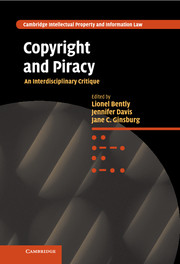Book contents
- Frontmatter
- Contents
- Notes on the contributors
- Editors' preface
- Table of cases
- Table of statutes
- Part I Introduction
- Part II History
- Part III Comparative Law
- Part IV Economics
- Part V Linguistics
- Part VI Computer software
- Part VII Information studies
- 12 Measuring text reuse in the news industry
- 13 Reflections on measuring text reuse from a copyright law perspective
- Part VIII Literature
- Part IX Art
- Part X Sociology/music
- Part XI Criminology
- Bibliography
- Index
12 - Measuring text reuse in the news industry
from Part VII - Information studies
Published online by Cambridge University Press: 17 November 2010
- Frontmatter
- Contents
- Notes on the contributors
- Editors' preface
- Table of cases
- Table of statutes
- Part I Introduction
- Part II History
- Part III Comparative Law
- Part IV Economics
- Part V Linguistics
- Part VI Computer software
- Part VII Information studies
- 12 Measuring text reuse in the news industry
- 13 Reflections on measuring text reuse from a copyright law perspective
- Part VIII Literature
- Part IX Art
- Part X Sociology/music
- Part XI Criminology
- Bibliography
- Index
Summary
Introduction
The activity of text reuse describes the situation in which pre-existing written material is consciously used again during the creation of a new text or version. This might include the reuse of an entire document (e.g. in the case of duplicate web pages), or smaller segments (e.g. chunks, paragraphs and sentences) from one or more existing texts. From the author's perspective, the process of reuse involves ‘finding the relevant material, modifying it as needed and stitching the pieces together’. This may involve a process of text rewriting (or editing), with the author reusing existing material with (or without) permission from the owner. From the reader's perspective, text reuse can be cast as a problem of text analysis or attribution: given two texts is it possible to determine, within an acceptable degree of probability, whether one text is derived from the other? Identifying text reuse can be difficult due to the degree of textual transformation that can occur, from simple cut-and-paste reuse to more complex cases involving paraphrasing and summarisation making the revised version appear very different to the original text. One might add to this that recent advances in technology are also making the activity of text reuse easier. For example, the search engine Google indexes and makes easily accessible billions of web pages on a diverse range of topics and in many different languages. Being able to discover such documents may promote their use as a basis for new texts.
- Type
- Chapter
- Information
- Copyright and PiracyAn Interdisciplinary Critique, pp. 247 - 259Publisher: Cambridge University PressPrint publication year: 2010
- 3
- Cited by



